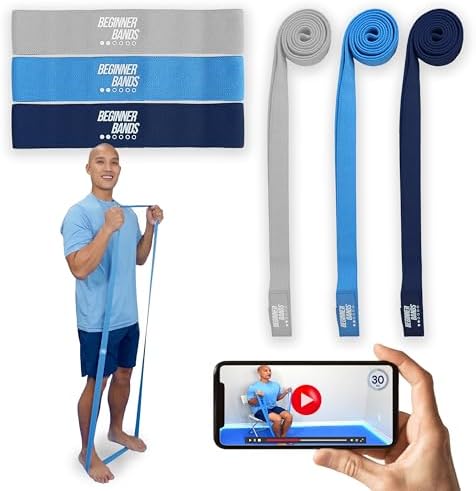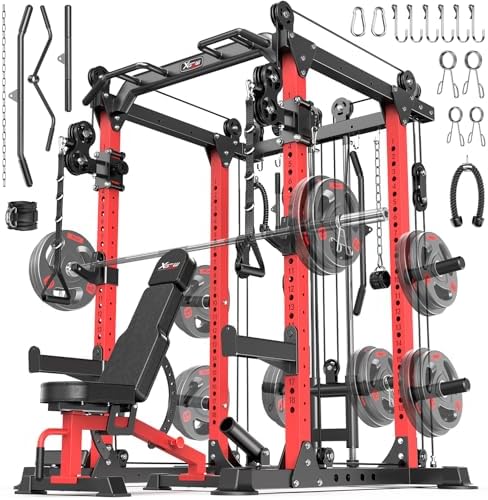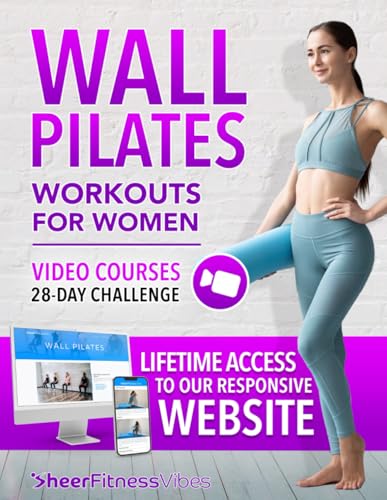Top 7 Beginner Workouts at Home for Busy Professionals: Efficiency Meets Fitness
This post may contain affiliate links. If you purchase through these links, I may earn a small commission at no extra cost to you. LEARN MORE.
For many busy professionals, finding time to hit the gym regularly can be a challenge.
The convenience of exercising at home is appealing because it saves time and can be done at any hour that fits a hectic schedule.
Home workouts provide a flexible yet effective way to stay active and maintain overall health, even with a packed calendar.

The beauty of home workouts is that they can be tailored to fit any level, especially beginners.
Simple exercises that require little to no equipment can be just as effective in building strength and improving fitness levels.
Getting started with a workout routine doesn’t have to be overwhelming; small, consistent steps can lead to significant progress.
Home workouts empower individuals to take control of their fitness journey.
By integrating these workouts into daily life, anyone can improve their physical well-being without sacrificing precious time.
A thoughtful approach ensures success while maintaining safety and maximizing results.
If you’re also looking to optimize your results with a personalized nutrition plan, consider starting a Custom Keto Diet tailored to your body goals. It complements your home workout efforts by supporting fat loss and energy naturally.
Key Takeaways
- Home workouts suit busy schedules and save time.
- Beginners benefit from simple, equipment-free exercises.
- Consistent home workouts boost health and fitness.
Benefits of Home Workouts for Busy Professionals

Home workouts offer several advantages for busy professionals.
They provide time efficiency and flexibility, boost productivity and energy, and support consistency in fitness routines.
Each benefit directly supports those with demanding schedules, helping them maintain a healthy lifestyle without sacrificing too much time.
Time-Efficiency and Flexibility
Home workouts are time-saving, allowing professionals to exercise according to their own schedules.
They eliminate the need for travel to and from a gym, which can save precious minutes.
This is especially useful for those with packed calendars.
Flexibility is another key benefit.
Home workouts can be adapted to any time of day, fitting in easily between meetings or family responsibilities.
This adaptability means one can work out whether they have 15 minutes or an hour.
They allow individuals to choose exercises that target specific needs or goals.
Professionals can focus on different types of exercises, such as cardio or strength training, to maximize their results based on available time and energy.
Boosting Productivity and Energy
Engaging in physical activity can significantly boost energy levels.
Simple exercises performed at home increase blood circulation and oxygen flow, which are essential for maintaining alertness and focus throughout the day.
Home workouts can also reduce stress.
Lower stress levels often translate to better concentration and work efficiency.
This improvement in mental clarity can make a big difference in a busy professional’s daily performance.
By incorporating regular workouts into their routine, many find they experience an overall enhancement in mood.
This mood boost can enhance professional interactions and decision-making, contributing to a more positive work environment.
Supporting Consistency in Fitness Routines
Consistency is crucial to reaping the full benefits of any fitness routine.
Home workouts facilitate this by removing barriers such as bad weather or conflicting gym schedules.
They ensure that one can continue exercising regardless of external circumstances.
The ability to work out anytime helps in building a habit, which is key in maintaining a long-term fitness plan.
Easy access to workout resources at home makes it simpler to perform physical activities consistently, leading to better health outcomes.
For busy professionals, setting a regular workout schedule can help in maintaining discipline and achieving fitness goals.
This consistency results in steady progress and a sustained commitment to personal health.
Maintaining consistent habits becomes easier when you understand how nutrition strategies like intermittent fasting with keto support energy levels.”
Getting Started: Setting Up for Success

To begin a fitness routine at home, choose a comfortable space, gather essential equipment, and understand your fitness level.
These steps help create a solid foundation for maximizing workout effectiveness.
Choosing the Right Space
Selecting the right space at home is crucial for workouts.
It should be free from clutter, away from distractions, and have enough room to move freely.
Adequate ventilation and good lighting make the environment more inviting and less stressful.
Incorporating a mat or an area rug can provide comfort, especially for exercises done on the floor.
An open area allows flexibility for different workouts and accommodates varied movements like lunges and jumping jacks.
Consistent use of this space reinforces the habit of exercising regularly.
Essential Equipment and Bodyweight Options
Getting started doesn’t require extensive equipment.
Basic items like a yoga mat, resistance bands, and dumbbells are versatile and effective for building strength.
Resistance bands are great for adding intensity without needing bulky equipment.
Bodyweight exercises such as push-ups, squats, and planks are powerful tools for beginners.
They help improve strength and endurance without extra equipment.
These exercises are efficient and can be modified to match different fitness levels, making them adaptable as progress is made.
A few minimalist fitness tools and smart meal strategies can help you stay fit with less effort.
Check out the top equipments for beginners from Amazon below.
Assessing Your Fitness Level
Understanding one’s current fitness level is key to choosing appropriate exercises and avoiding injury.
Beginners should assess their strength, flexibility, and cardiovascular endurance.
Simple tests like how many squats or push-ups someone can do can offer insights.
Tailoring workout intensity based on fitness level ensures safety and effectiveness.
If someone is unsure about their capabilities, consulting a fitness professional or using online resources can provide helpful guidance.
Starting gradually and increasing intensity over time helps build confidence and achieve better results.
Fitness and food go hand in hand. While setting up your space, also consider setting up your nutrition with the Custom Keto Diet program, designed to align with your fitness level and time constraints
Top 7 Beginner Workouts at Home

Focusing on bodyweight exercises is an excellent way for beginners to develop strength and stability.
These exercises target multiple muscle groups, ensuring a balanced workout.
Here are some effective workouts to help individuals build a solid fitness foundation.
Bodyweight Squats for Lower Body Strength
Bodyweight squats are fundamental for enhancing leg strength and stability.
They target the quads, hamstrings, and glutes.
Performing squats regularly can improve balance and mobility.
To execute a squat, stand with feet shoulder-width apart, then lower the hips as if sitting in a chair.
Ensure the knees don’t extend beyond the toes.
Aim for multiple sets of 10-15 repetitions.
This workout can be scaled up by adding more reps or holding a squat position for longer.
Lunges to Improve Leg Power and Balance
Lunges are excellent for developing leg power and improving balance.
They work the quads, glutes, and hamstrings while engaging core muscles for stability.
Start with feet together, step one foot forward, and lower the hips until both knees are at 90 degrees.
Keep the back straight and chest up.
Alternate legs and perform 10-12 repetitions on each side.
Adding weights or increasing repetitions can make this exercise more challenging.
Planks for Core Stability and Abs
Planks are crucial for core stability and defining the abs.
They strengthen the entire core, including the shoulders and back.
Begin in a push-up position, with weight on the forearms and toes.
Maintain a straight line from head to heels.
Hold the plank for 20-30 seconds, gradually increasing the duration as core strength improves.
Variations like side planks can enhance oblique muscle engagement.
Tricep Dips for Upper Body Toning
Tricep dips focus on the triceps and enhance upper body strength.
They also work the chest and shoulders.
To perform a dip, use a sturdy chair or low table.
Sit on the edge, place hands beside the hips, and extend legs forward.
Lower the body by bending the elbows, keeping them close to the body.
Rise back to the starting position.
Aim for 10-15 reps per set, adjusting the leg position to modify intensity.
Adding Variety: More Effective Exercise Options

Adding different exercises to home workouts can make them more exciting and effective.
Simple moves like jumping jacks, burpees, and calf raises are great options that can fit into any busy schedule and help improve overall fitness levels.
Jumping Jacks as a Cardio Warm-Up
Jumping jacks are a classic exercise that boosts cardiovascular health.
They are a good choice for a warm-up as they increase heart rate and prepare muscles for more intense activity.
To perform jumping jacks, stand with feet together and arms by your side.
Jump up, spreading your legs shoulder-width apart while raising your arms overhead.
Jump back to the starting position.
Aim for 30 seconds to 1 minute of continuous jumping jacks to kick-start your workout.
Benefits: Jumping jacks improve endurance and coordination, making them beneficial for people at any fitness level.
The movement is simple, easy to perform anywhere, and doesn’t require equipment, making it ideal for home workouts.
Including them in your routine as a warm-up can lead to improved cardio performance over time.
These cardio moves help jumpstart your morning routine just like a good low-carb breakfast.
Burpees for Full-Body Engagement
Burpees are an effective full-body exercise.
They work multiple muscle groups and improve strength, flexibility, and endurance.
Starting in a standing position, move into a squat, place your hands on the floor, kick your feet back into a plank, return to the squat, then jump up.
Benefits: Burpees increase heart rate rapidly, making them excellent for cardio.
They engage the chest, arms, thighs, and core, providing a comprehensive workout.
Doing them regularly helps enhance overall fitness levels and is especially useful for those looking to maximize their exercise time.
For beginners, starting with 5-10 reps can offer significant benefits without overwhelming the body.
Calf Raises to Strengthen the Lower Legs
Calf raises focus on the lower legs, specifically the calf muscles.
They are simple to do and highly effective in building lower leg strength.
Stand with feet hip-width apart, lift your heels, and stand on your toes.
Lower back slowly.
Benefits: This exercise helps improve balance and stability.
Strong calves contribute to better performance in various physical activities.
Calf raises can be modified by using a step or adding dumbbells for increased difficulty.
Incorporating them into a routine aids in overall lower body strength and complements other exercises like running or cycling.
Maximizing Results: Technique, Safety, and Progression

Proper technique, adjusting workout intensity, and tracking consistency are key to improving fitness.
Focus on correct form to reduce injury risk, tailor rep and set schemes for personal goals, and maintain a routine for better results.
Mastering Proper Form and Technique
Proper form is essential to avoid injuries and get the most out of a workout.
When doing exercises like squats or push-ups, maintaining alignment is critical.
For strength training, keeping the back straight and knees over toes helps stabilize the body.
High-Intensity Interval Training (HIIT) requires quick transitions between exercises.
Clear technique ensures each move is effective and safe.
Controlled breathing supports better form.
Sloppy form can lead to muscle strain or accidents, so it’s useful to start slowly to spot mistakes.
Adjusting Reps and Sets for Your Goals
Customizing reps and sets allows workouts to align with different fitness goals. Beginners should start with moderate reps (e.g., 8-12) at a comfortable weight to build muscle endurance.
For strength, lower reps (e.g., 4-6) with heavier weights might be more effective.
HIIT is effective for burning calories quickly, focusing on short, intense bursts followed by rest. A typical HIIT session could include 20 seconds of intense activity with 10 seconds of rest, repeating for up to 20 minutes.
Tracking Progress and Staying Consistent
Consistency is key to achieving long-term results. Keeping a workout journal to track exercises, reps, and sets helps spot patterns and progress over time.
This recording process can motivate and reveal areas for improvement. Setting specific and achievable goals is crucial.
Whether aiming to increase reps or complete an extra workout per week, tracking progress supports sustained motivation. Scheduling regular workouts, even short ones, helps maintain routine and benefits overall health.
For more beginner workout at home, check out the top selling book from Amazon below.
Integrating Flexibility, Mobility, and Recovery

Busy professionals can greatly benefit from exercises that combine flexibility, mobility, and recovery. This not only helps in maintaining an active lifestyle but also improves joint health and reduces stress.
Paying attention to effective workouts ensures that recovery becomes an essential component of a fitness routine.
Incorporating Yoga and Pilates
Yoga and Pilates are excellent for enhancing flexibility and stability. They focus on gentle movements and breathing techniques.
Yoga includes poses that stretch and strengthen the muscles, like the downward dog and child’s pose. Pilates emphasizes core strength, which helps in maintaining proper posture and support.
Incorporating these activities a few times a week can aid in reducing tension in the shoulders and back. They also provide a relaxing way to wind down after a hectic day.
These practices support mental well-being and improve body awareness, which can prevent injuries.
Gentle yet effective workouts can reduce stress, which is also key when managing hormones, like in PCOS with keto.
Mobility Drills for Joints and Hips
Mobility drills are crucial for keeping joints and hips healthy. Movements like ankle alphabets and hip circles enhance joint function and improve range of motion.
These drills also support daily activities, such as walking or climbing stairs, by keeping joints flexible. Practicing drills that target the thoracic spine can relieve stiffness and enhance overall mobility.
Regular practice of these exercises can make a noticeable difference in comfort levels and prevent common aches linked to desk jobs. For optimal benefits, aim for 10-15 minutes of mobility exercises daily.
Importance of Recovery and Stretching
Recovery and stretching are vital for preventing injuries and aiding muscle repair. Dynamic stretches, like leg swings and arm circles, prepare the body for more intense physical activity.
After exercise, static stretches relax muscles and help them return to their resting length. Taking time for recovery ensures that muscles repair effectively, which boosts performance over time.
Including rest days in the workout regimen allows the body to heal and adapt. Using tools like foam rollers can also aid in muscle recovery by releasing built-up tension.
Frequently Asked Questions
Busy professionals can work out effectively at home with simple routines. These workouts often require no equipment and include exercises for full-body fitness, strength training, and more.
What is an effective full-body workout routine at home for beginners with no equipment?
Beginners can start with bodyweight exercises like squats, lunges, push-ups, and planks. These exercises target major muscle groups and can be done in a small space.
Aim for 2-3 sets of 10-15 reps for each exercise to build strength and endurance.
How can busy professionals integrate a simple strength training program at home?
Scheduling short workout sessions helps busy people stay consistent. Choose a time that fits into daily routines, like morning or during lunch breaks.
Include exercises such as push-ups, squats, and planks that require little setup and can be completed quickly.
Can you suggest a workout plan for beginners wanting to get back in shape without leaving the house?
A simple plan could include three weekly sessions mixing cardio and strength exercises. For example, spend 20 minutes on jumping jacks, high knees, or jogging in place, and follow with 15 minutes of strength exercises like push-ups and squats.
What are the best no-equipment workouts for men starting a fitness regimen at home?
Men starting a home workout can focus on push-ups, squats, burpees, and planks. These exercises build muscle and improve cardiovascular health.
Start with moderate intensity and gradually increase the difficulty as strength and endurance improve.
Are there comprehensive, free home workout plans available in PDF format?
Yes, many websites offer free PDF workout plans. These plans often include detailed routines and tips for beginners.
Searching online or visiting fitness forums might lead to useful resources and community recommendations.
What are some efficient home exercises for beginner women with no equipment?
Women can include exercises like bridges, squats, lunges, and tricep dips in their routines. These exercises target key muscle groups and can be easily modified for different fitness levels.
Consistency and gradual progression will aid in building strength and fitness over time.
Conclusion
Finding time to exercise can be tough for busy professionals.
Simple home workouts make it easier to stay active without leaving home.
Each workout in this article is designed for beginners.
They don’t need fancy equipment or much space.
Trying different workouts helps keep things interesting.
This can help one find what works best for their schedule and fitness level.
From yoga to resistance band exercises, variety is important.
Tracking progress with a journal or fitness app can help.
This way, improvements can be seen over time.
Small changes can add up to big results.
It is important to listen to one’s body and not push too hard.
Rest days are vital for recovery.
Balancing work and fitness leads to healthier living.
Remember, achieving your ideal physique is about consistency in both movement and meals. The Custom Keto Diet is a great step toward simplifying your health transformation.






